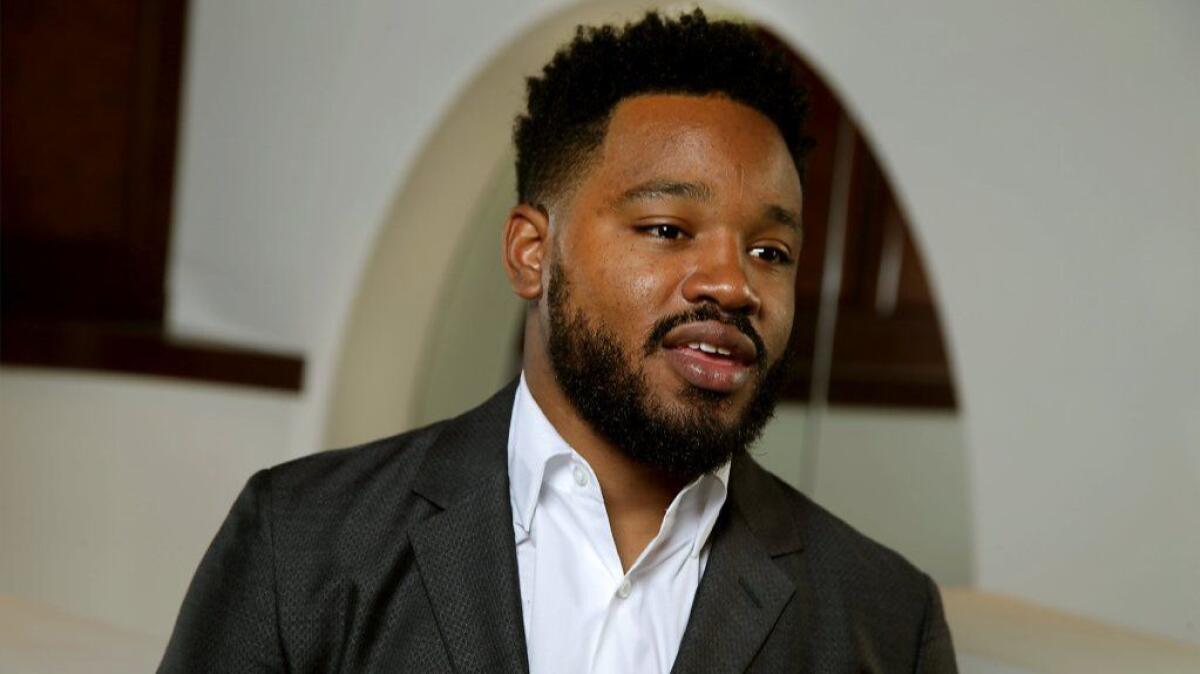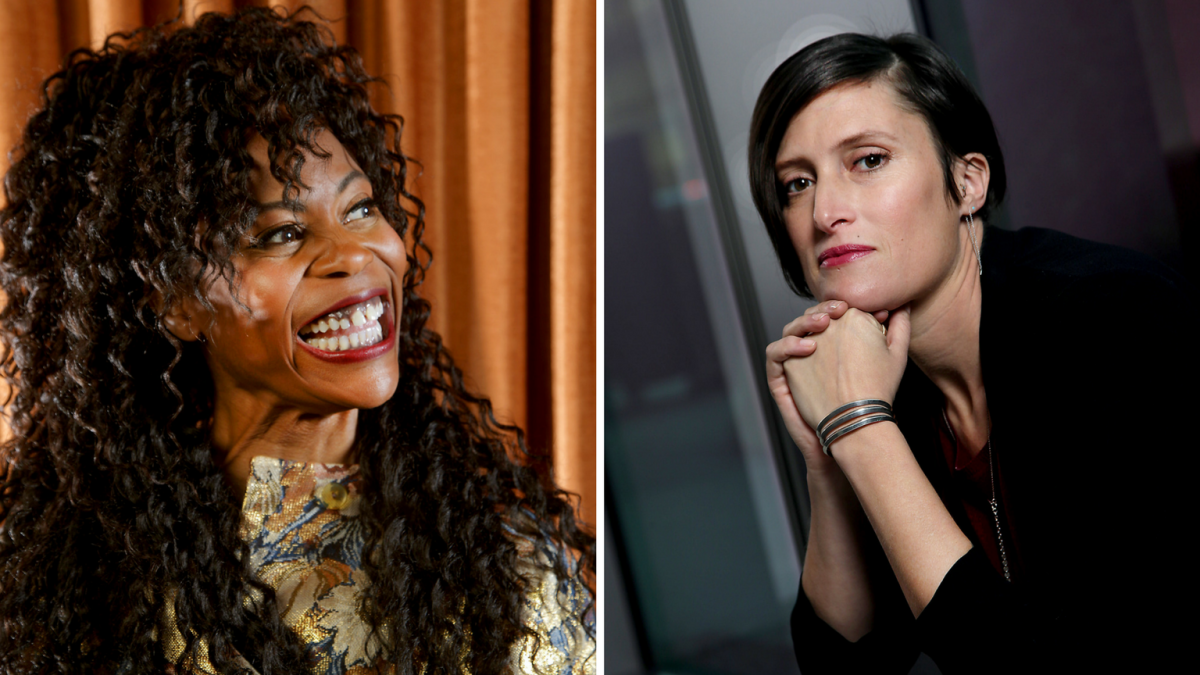Why ‘Black Panther’ is Ryan Coogler’s most personal film to date

- Share via
Being a black American sometimes comes with an identity crisis. After all, parts of African American culture are rooted in a land some of them will never know thanks to colonialism, imperialism and slavery. The result, hundreds of years later, is a generational distance.
“One of the things that sometimes comes with being [of African descent] is being made to be ashamed of being African and ashamed that your people live in these beautiful huts and ashamed that some of your people are running around with no shoes on and that when the music plays, we dance like no one’s watching,” Ryan Coogler said. “But that ... is beautiful and we can be proud of it.”
This is the one of the messages the co-writer and director wanted to ensure audiences received from his latest picture, Marvel’s “Black Panther,” in theaters Friday. To execute his vision, however, he knew he needed the right people around him.
What does it mean to be African?
— Ryan Coogler
“Black Panther,” set in the fictional African nation of Wakanda, follows T’Challa (Chadwick Boseman) who, after the death of his king father, returns to their homeland to assume the throne. Upon being crowned he must defend his nation — an isolated, technologically superior place that houses a secret stockpile of the powerful metal vibranium — from an interloper played by Michael B. Jordan. The ensemble cast is rounded out by Lupita Nyong’o and Danai Gurira who lead the nation’s all-female army, (current Oscar nominee) Daniel Kaluuya, Forest Whitaker, Letitia Wright, Winston Duke and Angela Bassett.
The film has already been hailed for its historic nature — a black-led picture of this magnitude is unheard of — its unapologetically African inspiration and its unflinchingly black context, all an Afrofuturist’s dream. From the moment it was announced that Coogler had signed on to the film nearly two years ago, he knew he couldn’t squander the opportunity.
Coogler decided he wanted to work with folks who knew his style and perspective. He chose a team led by women, Hannah Beachler as his production designer and Rachel Morrison as his cinematographer.

Coogler first met Morrison and Beachler while searching for behind-the-camera talent for his indie debut “Fruitvale Station.” That film started a working relationship and friendship between the trio, among others behind the scenes. Beachler has been the production designer for all of Coogler’s films while Morrison had to skip his second picture, “Creed.” (She was pregnant with a due date during the “Creed” shoot.)
After getting his team in place, Coogler realized that many of them, including himself, had never been to Africa. He staged a research trip for the crew to the continent to experience the environment firsthand. Beachler landed first.
“I called Ryan,” she said, struggling to find words to capture the experience. “I was there for a week and it was emotional ... feeling these connections [to a place] that you never really knew.”
“As many pictures of it as you’ve seen,” Coogler added, “there’s nothing a camera can do for [you that] your eyes do, or being a person of African descent, what your body does when you touch down there. It’s a feeling I couldn’t put into words, but I tried to put it into the movie.”
That trip set the stage for the production design as the team zeroed in on the continent’s unique topography. (Coogler also wrote parts of the script while in South Africa.)
“It was important to make sure Wakanda didn’t feel like it was a city,” Coogler said. “Sometimes in the comics, you don’t get the sense of how big or small Wakanda is. We wanted it to feel like a country.”
And reflecting what they saw on their trip, “Black Panther” showcases a pleasant mix of folks living more traditional, tribal lifestyles and those “people that are fully in the city life, but it’s an African city life.”
Wakanda also took inspiration from a number of African landmarks, including South Africa’s Three Rondavels (also known as the Three Sisters, a trio of geological peaks shaped like beehive huts) and Orbi Gorge, a canyon in southern KwaZulu-Natal.
To be African is to be artistic...
— Ryan Coogler
“Ryan was like, we should put Rondavel tops on the skyscrapers and as soon as we did that, Golden City transformed,” Beachler said. “And Orbi Gorge informed Warrior Falls and how the rock looks, the sediment, the color of the dirt, the way the mountains come together.”
Beachler, who also designed Beyoncé’s “Lemonade” and last year’s Oscar winner “Moonlight,” credits Coogler’s perspective for what Wakanda finally ends up looking like.
“One of the most important things I learned from Ryan is sense of place, and that’s because of his connection to the [Northern California] Bay,” she said. “I had never met anyone who had such a profound connection to a place. That way of seeing things outside of what people normally see is why Ryan’s films are the way they are.”
For all of his Coogler-isms, Morrison added, the writer-director is “incredibly technically savvy.”
“He’s one of those directors that took the time to study what the different focal lengths are and what they make you feel and what resonates with him,” she said. “He’s a real film aficionado and cinephile and speaks from a great base of knowledge in terms of cinematic references as well as camera movement and lensing.”
In the conversations about how to capture what Beachler was concocting on film Morrison — who made history this year as the first woman to be nominated for the cinematography Oscar for her work on “Mudbound” — said Coogler referenced a variety of inspirations including Ron Fricke’s nonverbal “Baraka” and “Samsara,” “The Godfather,” “Sicario” and “The Dark Knight.” They even looked at an episode of “Chef’s Table.”
And when it came to realizing that vision, this time they had Marvel money. “Fruitvale Station” was made for under $1 million, while “Creed” had a $40-million budget. “Black Panther” has a reported $200-million price tag.
That glow-up gave Coogler and team the opportunity to create as many physical sets as they wanted, as opposed to sets created purely by visual effects — “It was great to have something that grounded everyone,” Morrison said — and make use of as many camera tools as needed.
“It’s a much bigger machine, and what that means is you can do really cool camera moves, but it’s also a slower beat,” Morrison said, adding that “you can’t just steal a shot. Half of ‘Mudbound’ were shots I stole in between other scenes.”
Both Beachler and Morrison credit Coogler with standing by them and helping convince Marvel to give them a shot — despite never having worked on a film even close to the scale of “Black Panther.”
And while film history is littered with examples of this kind of massive undertaking compromising a filmmaker’s perspective and approach, Morrison said the “Black Panther” set was just like any other Coogler project. The result is a “big film with action sequences but it’s made by the smaller moments and human interaction and letting the audience connect with our characters and letting the characters connect with each other,” she said.
Perhaps that’s because of the central question that Coogler took with him throughout the entire writing and filming process, a question he says “made this movie the most personal that I’ve ever made.”
“A big thing for me is the question of ‘What does it mean to be African?’” he said, “As a result of this thing that you are and have no control over, you’re gonna have to deal with certain situations in a certain way — and sometimes those situations can cost you your life. When I found myself asking that question, I hadn’t even been to the place.”
Throughout this process, he found an answer.
“To be African is to be artistic,” he said. “We wear our art on our clothes. We paint on the walls. We bang it out in our music. We use our voice. We wear it on our skin. When we find an African, you’re gonna find flyness, by any means necessary, whether they use Mother Earth to create the paint on their faces or make their own clothes.
“And that’s why I needed someone like Hannah for these walls and how this city will look and get everything together,” he said. “Because Hannah is an African, an African that was born in Ohio.”
Get your life! Follow me on Twitter (@TrevellAnderson) or email me: [email protected].
More to Read
Only good movies
Get the Indie Focus newsletter, Mark Olsen's weekly guide to the world of cinema.
You may occasionally receive promotional content from the Los Angeles Times.











